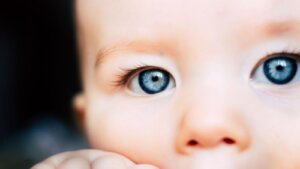Perceptual Constancy And What Babies Can See That We Can't


Written and verified by the psychologist Elena Sanz
We often assume that babies’ vision isn’t as good as adults. In fact, a newborn has extremely poor visual acuity. During the first months of life, they only manage to focus and discriminate between colors. However, infants are capable of identifying certain nuances that, to the eyes of an adult, are imperceptible. This is related to perceptual constancy.
Perceptual constancy doesn’t develop until approximately five or six months of age. At this stage, babies stop capturing certain subtleties. This may seem like a loss but it’s also a necessary process for understanding the world. Indeed, without perceptual constancy, it’d be really difficult for us to organize reality and understand the stimuli that surround us. We’ll tell you why below.

What do babies see and we don’t?
As we mentioned earlier, babies’ vision takes time to develop. In the early stages of life, it’s quite limited. In fact, a baby’s vision is blurry and they’re unable to focus on distant objects. They don’t perceive depth. Moreover, they haven’t yet developed stereoscopic (or three-dimensional) vision. In addition, it’s difficult for them to distinguish low-saturated colors, and they can’t discriminate between different shades of the same color.
Despite these limitations, babies have one particular advantage. They’re able to perceive nuances and differences in certain images due to lighting that adults can’t see. This was discovered by a study conducted in 2015. It measured the responses of several babies to three similar images (A, B, and C) with certain differences.
- A and B showed the same object but they differed in pixel intensity.
- B and C were more similar in pixel intensity. However, they differed in the fact that they had glossy and matt surfaces respectively.
The results showed that babies under five months were extremely capable of perceiving these nuances or variations in terms of pixel intensity. This is something that’s imperceptible to adults.
That said, babies don’t capture the difference in surfaces (glossy or matte) until they’re seven or eight months old. At this stage, they’ve also lost their initial perceptual advantage. In fact, between five and seven months they’re at their lowest point of perception. That’s because they haven’t yet acquired the perceptual constancy of mature vision.
Perceptual constancy and its importance
Why does the above happen? Why are there changes in visual capacity during the first months of life? The answer lies in the development of perceptual constancy. This term refers to the ability we have to perceive an object or a quality as constant, even if we don’t always experience it in the same way.
For example, you can recognize that a chair is a chair, or that your brother is your brother, even if the lighting conditions change. You can also distinguish an instrument even when you hear it at a different volume or played by different players. Or, you continue to correctly perceive an object no matter what position it’s in or how far away you are.
Perceptual constancy is, ultimately, the ability to take account of the various elements of an object and recognize it for what it is. Somehow, we create the illusion that there are no differences, and we stop noticing them. This ability has an important function.
In fact, perceptual constancy has been essential throughout evolution and continues to help us understand and function within our environment. Without it, we’d stop recognizing objects or people for the simple reason of looking at them from another perspective or because the lighting was different.

In what other situations is perceptual constancy relevant?
In short, perceptual constancy allows us to adjust to a stimulus and be able to discriminate the aspects that interest us the most, ignoring those that are irrelevant. However, although it’s a fundamental and necessary capacity, there’s a part of reality that becomes lost to us forever when we learn to discriminate.
For example, babies (who haven’t yet developed this ability) are able to identify and differentiate between different faces of monkeys (something that would be really difficult for an adult). In addition, it’s a phenomenon also related to the acquisition of speech.
Hearing develops and refines as a child grows, so in a baby it has limitations. Before acquiring perceptual constancy, babies are much more sensitive to acoustic variations and can easily distinguish pronunciations, accents, and nuances. For this reason, an infant has the ability to learn any language with great ease if they’ve been exposed to it from the beginning of their life. On the contrary, when we learn to discriminate, it’s far more difficult for us to capture the subtleties of each language and reproduce them.
In short, with all of the above, we know that our perception isn’t an accurate reflection of reality and that our senses ‘deceive’ us in order to help us make sense of our environment and respond to it.
Perceptual constancy isn’t innate but is developed and learned. As such, it’s probably a scheduled alteration as it’s so useful and necessary for us as a species.
All cited sources were thoroughly reviewed by our team to ensure their quality, reliability, currency, and validity. The bibliography of this article was considered reliable and of academic or scientific accuracy.
- Munar, E., Rosselló, J., Mas, C., Morente, P., & Quetgles, M. (2002). El desarrollo de la audición humana. Psicothema, 247-254.
- Yang, J., Kanazawa, S., Yamaguchi, M. K., & Motoyoshi, I. (2015). Pre-constancy vision in infants. Current Biology, 25(24), 3209-3212.
This text is provided for informational purposes only and does not replace consultation with a professional. If in doubt, consult your specialist.








